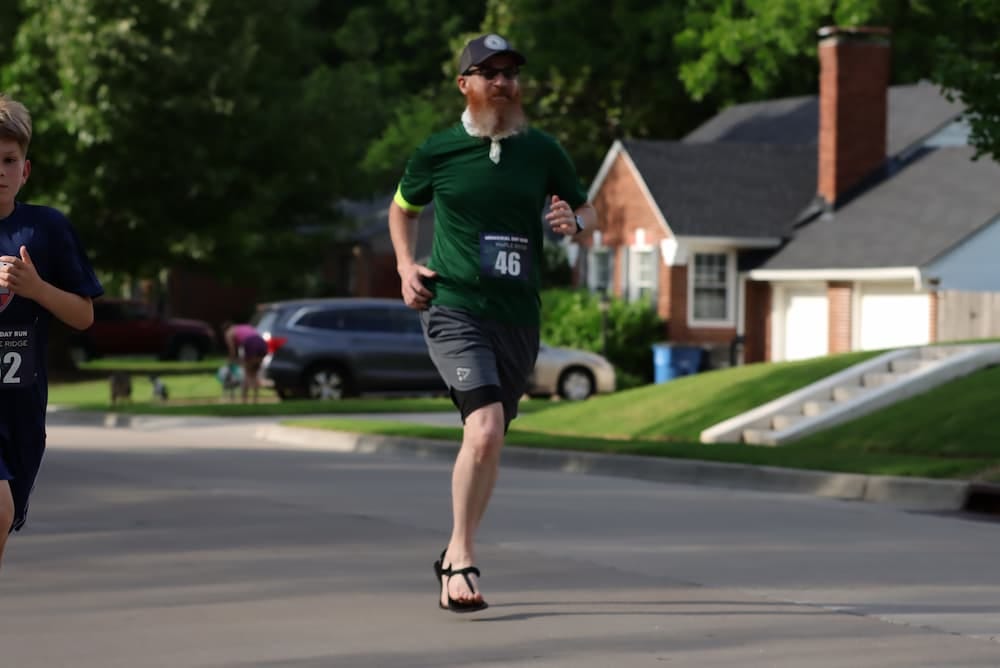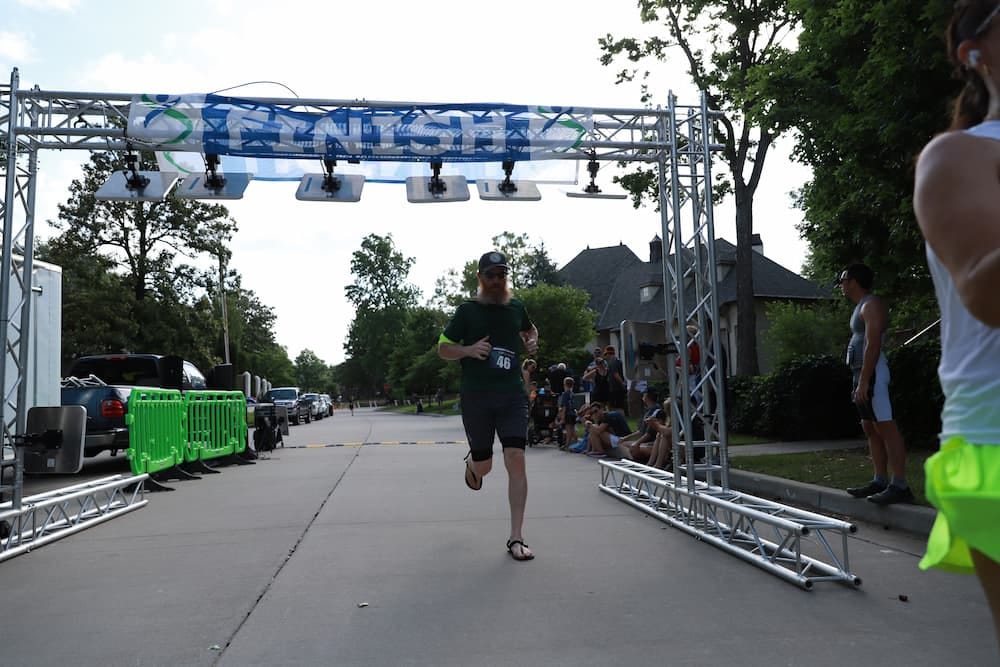How Is This the Best Thing That’s Happened to Me?
One of the last cool spring breezes of the year rolled over the historic neighborhood as folks of every age, shape, and goal-set pinned race number bibs to their shirts, stretched out legs, and bounced around in anticipation of the starting gun. Scanning the crowd for familiar faces, I spotted my Rabbi, his family, and many others from my synagogue. Minutes before the starting gun, I swam through the crowd of runners over to give my “good luck!” wishes and perhaps run alongside a few friends.
“I didn’t know you were a runner!” My Rabbi exclaimed, seeing me behind the starting line in my runner’s duds for the first time.
“Well, as of just the last couple of months. It’s a funny little story.”
“You’ll have to tell me sometime,” he said looking at his watch before looking back up, “or, just now.”
My eyes shot towards the bill of my cap as I processed the short version of the story.
“I used to jump rope on my backyard deck every morning. During Sukkot this fall, however, the best spot for our sukkah was where I would usually jump rope. So, instead of jumping rope, I went for runs in the nearby park that week. I ended up really enjoying running and, thus, why I’m here.” (Don’t worry, I’ll explain what on earth this means.)
“So, the Jewish holiday of Sukkot made you a runner?”
“I guess you could say that.”
I could see the Rabbi-wheels turning behind his eyes, pondering how the tale could be leveraged for the sake of Judaism.
As I wrapped up my short story, the starting gun went off.
We wished each good luck and I ran across the line. The cluster of runners became a long stream as their varying speeds stretched out the shape of the formation.
Putting one foot in front of another, I started to realize how what was originally perceived as an inconvenience led to what is now one of my favorite activities—one that has reshaped my relationship with my body, mind, and community.
And it was true; a Jewish holiday had made me a runner.
For many years, I had grown to enjoy jump rope. The activity was not only a great way to kickstart my day but had resulted in nearly 40 pounds of weight loss. My favorite place to jump rope was a section of a wooden deck in my backyard—just the right amount of give. However, this section of the deck was also the best place in my backyard for the construction of what is called a “sukkah.” Huh? Don’t worry—I’ll explain.
Every year, immediately after the Jewish holy day of Yom Kippur (the Day of Atonement), there is a week-long holiday called Sukkot (“sue-coat”)—the Festival of Booths. The “booths” reference the temporary dwellings that the Israelites lived in while traveling through the desert for 40 years. To commemorate this time, Jewish people erect temporary dwellings and host an array of festivities within. Our synagogue builds a sukkah on-site nearly the size of our sanctuary. My family does as well—erecting a 6x8 foot screened-in room with a roof made of bamboo thatch in our backyard. My non-Jewish friends just call mine “Ken’s Jewish Party Hut” and come over to clink a few pint glasses, eat some tasty grub, and enjoy the last of the temperate fall weather before winter forces us inside.
There was only one problem—my sukkah took my jump rope spot. Jumping rope on my concrete driveway was too firm and attempting to jump rope on another section of the deck presented the possibility of hitting low-hanging utility wires. Just greeeat.
It only took a few days of Sukkot before I started getting the itch to break a sweat. Leaving my jump rope behind, I headed off to a nearby park to attempt to scratch the itch with a walk. After a kilometer lap or so, it was clear that simply walking wasn’t going to cut it. So, I decided to pick up the pace and run.
After running a kilometer lap, my heart was racing and my lungs were looking for air wherever it could be found. It felt great. Though my cardiovascular system was grinning, my legs, knees, and hips were not. Being clueless about proper technique, I had forced them to carry me around the track—pounding my lower extremities against the pavement.
My quest to figure out how to run properly took me through a whirlwind of technique tutorials far exceeding the week of Sukkot. I dove headfirst into any books and videos I could find on the subject, including:
The acclaimed book Born to Run by Christopher McDougall
“Barefoot Ken Bob” Saxton’s guide to Barefoot Running: Step-by-Step
And finally, the game-changer: Keith Bateman and Heidi Jones’s book Older Yet Faster
It didn’t take long before I was fairly obsessed. I went from pushing myself to 5k (or 3.1-mile) distances at slower paces (well over 11 minutes per mile) to breaking a 12-mile distance barrier and finally being able to run a mile in under 8 minutes.
More than fitness, running became a practice—as important for my mind as much as my body. Figuring out how to improve or seeing what my body can accomplish feels like gradually working on a huge puzzle with little boosts of encouragement every time a new piece falls into place.
Even though I could ramble on and on about what I think about while I’m putting in miles (absolutely nothing, refreshingly enough) and what drives me to put one foot in front of another, my favorite fictional runner already summarized this in the 1994 film Forrest Gump,
“I just felt like running.”
But the events that eventually led to my love of running originally came from a much darker place: cancer.
In 2017, I was diagnosed with and treated for testicular cancer—an experience that forever changed my relationship with my own body. After bouts of health anxiety in the wake of such treatment and surveillance, I started jumping rope.
Thus, my cancer inspired me to seek fitness as a means of preserving my mind and body. If you poke around online, you’re likely to find hundreds of such stories of folks, who, after staring death in the face, went on to change their lives for the better.
Though I had successfully transformed what was the worst thing that could have happened to one of the best things, it wasn’t until about a week ago that I realized this—as well as how much time and pain I could have avoided if I’d had such foresight instead of this hindsight.
But wishing for foresight makes about as much sense as wishing for a crystal ball. What we can do is ask ourselves one question: How could this situation actually be the greatest thing that’s ever happened to me?
This practice was first introduced to me through a YouTube video called “8 Habits that Changed My Life” by the creator Struthless. I remember watching this video on my couch while nursing a case of metatarsalgia (inflammation of the forefoot) that kept me from running. The host mentioned a mental exercise he had taken on—simply, when faced with a difficult situation, instead of getting frustrated, asking one’s self, “How is this the best thing that’s ever happened to me?”
What was a frustrated pity party with a side of an itch to run became wondering…how is this the best thing that’s ever happened to me?
In this instance, I realized that my metatarsaliga was a symptom of a larger problem—my running form. I was landing on my forefoot with too much force. I used my downtime to figure out how to remedy the problem and how to distribute force across my entire foot. After doing so, I ran my fastest mile ever about a week later—even faster than I was before my injury.
While helpful, I feel like my piddly instance of going from a sore foot to breaking a personal record is just at the lower tier of how this mental exercise can be utilized. What if I had asked myself, “How is this the best thing that’s ever happened to me?” when I received my cancer diagnosis? Then, maybe I could have avoided a year or two of anxiety and hopped into fitness even sooner. I have no idea.
I feel that this mental exercise can change or even save someone’s life.
Instead of spiraling into deep depression or anxiety, someone can ask this question and begin to see a way out of despair.
Instead of seeing adversity as a speed bump, they can ask this question and use such an instance as, instead, a launch ramp.
Instead of letting a setback ruin your day, you can ask this question, reframe your vision of a problem, and pivot toward personal success.
Instead of seeing an event as the last shoe to drop, you can see it as the starting gun to wake you from procrastinating your own betterment.
How is what is going wrong in your life actually the greatest thing that’s ever happened to you? How can you make it so?


